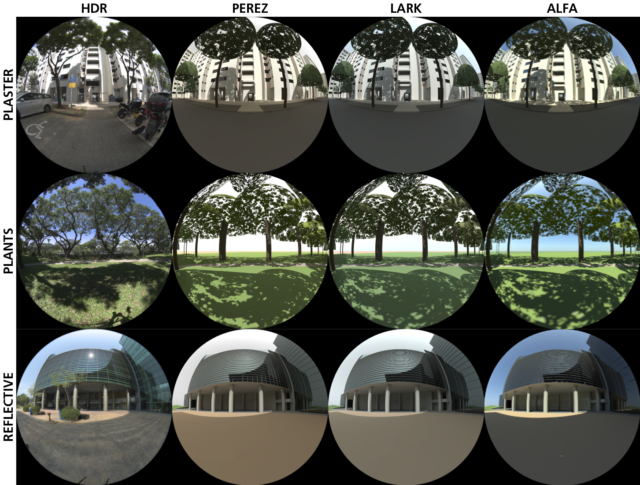
Ph.D. thesis by Priji Balakrishnan, Singapore University of Technology and Design
The distinctiveness of natural light in a built environment is a confluence of its physical feature––buildings, trees, and the ground––with its region-specific daylight source––the sun and the sky. The colours and patterns we see around us at different scales of cities, neighbourhoods or streets is the result of these complex interactions between the physical features and characteristics of its daylight. The current daylighting modelling workflows do not account for this distinct quality of light as the focus of performing a daylight simulation is to predict and plan for optimal quantities of light. Hence, surrounding buildings are usually modelled as ‘obstruction’ boxes with an assumed average reflectance of 30%; trees are modelled as spheres, cones or cylinders with assumed reflectance of 20%; and equal spectral energy sky models such as the CIE standard or all-weather Perez skies are used that lack spectral and colorimetric information. Two of the prime attributes of daylight in Singapore and an equatorial climate––patterns of light through trees and colour renditions of the built environment due to changing colours of the sky––are currently not represented in daylight prediction workflows. Therefore, the goal of this research is to first measure and model light through trees, and second measure and model interactions of Singapore’s built environment under various sky conditions typical of an equatorial climate. The first phase of the research presents the open-source program to generate a tree crown model that mimics the distribution of the measured leaves and gaps of a tree. This tree crown model, when used in daylight simulation workflows, helps predict their unique spatial and temporal transmittance and shadow patterns. In the second phase of the research, a detailed analysis of the spectral and colorimetric characteristics of the equatorial sky and its influence on Singapore’s built environment is presented. Two multi-spectral daylight rendering platforms are also compared for their visual, spectral and colorimetric representations of the equatorial light. This phase provides a framework for architects and designers to compute climate and context-specific daylight information and use an appropriate multi-spectral daylight rendering platform to compute colour-dependent visual perceptions.
The full Ph.D. thesis can be accessed here.
Contact Email: prijibalakrishnan@gmail.com
Additional Information: http://priji.com/



